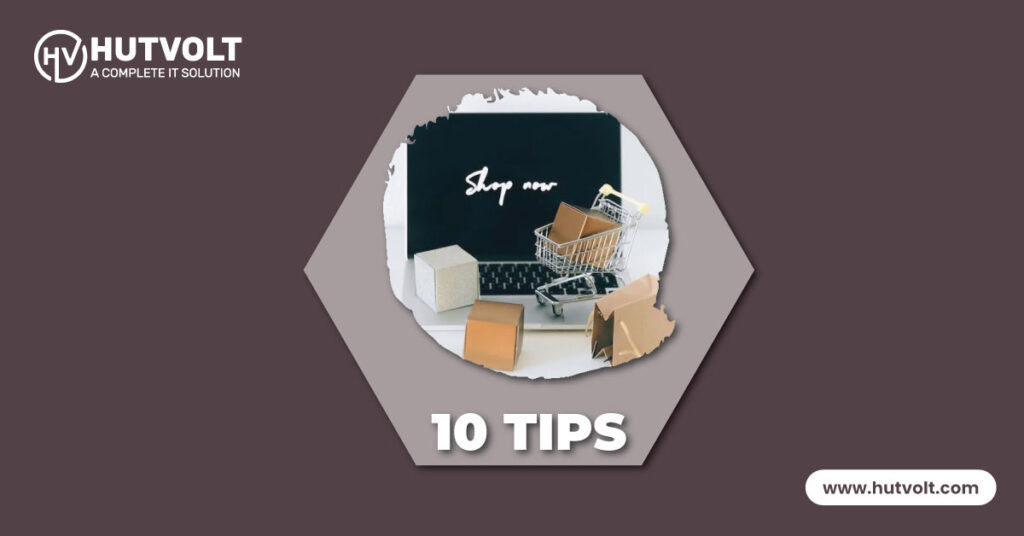eCommerce web design is the art of crafting beautiful and user-friendly websites that enable businesses to sell their products or services online. It involves creating a website that is optimized for online sales, secure, speedy, and mobile-friendly.
Creating an effective eCommerce website design isn’t a simple task. It takes a lot of thought and effort to ensure your website stands out from the competition. However, with the right tips and tricks, you can make sure your eCommerce website looks and functions like a professional one. In this blog, we will discuss 10 important eCommerce Web Design tips & tricks that you can use to create an effective eCommerce website. With these tips, you will be able to build an eCommerce website that looks professional and encourages customers to purchase your products. So, get ready to take your eCommerce website to the next level!
Tip 1: Understand Your Target Audience
The first step in designing an effective eCommerce website is to understand who your target audience is. Knowing who you’re trying to reach will help you create a website that meets their needs and expectations. Identifying your targeted audience involves asking yourself questions such as: Who are my customers? What do they need from my website? And what do they expect from me?
Tip 2: Make Your Site Mobile-Friendly
Having a mobile-friendly website is a must in today’s world. Mobile devices are increasingly becoming the preferred method of accessing the internet, and having a website that looks great on any device is essential. There are many benefits to having a mobile-friendly website, such as increased customer engagement and improved search engine rankings. To ensure your website is mobile-friendly, you should use responsive design and ensure that all of your pages are optimized for mobile devices.
Tip 3: Use Clear & Concise Content
One of the most important aspects of eCommerce web design is having clear and concise content. Your website should be easy to understand and navigate, and having clear, concise content will help make this process simpler. There are many benefits to having clear and concise content, such as better customer engagement and improved search engine rankings. To create clear and concise content, you should use simple language, avoid using jargon, and focus on providing valuable information.
Tip 4: Invest in Quality Graphics
It’s no secret that visuals are powerful tools when it comes to digital marketing. Quality graphics can help capture the attention of your target audience and improve the overall customer experience. There are many benefits to having quality graphics, such as increased conversions and improved search engine rankings. To create quality graphics, you should invest in professional graphic design services and use high-resolution images.
Tip 5: Increase Site Navigation
A well-designed navigation system is essential for any successful eCommerce website. Having a website that is easy to navigate helps make the customer experience smoother and increases the likelihood of them making a purchase. There are many benefits to having improved site navigation, such as increased customer engagement and improved search engine rankings. To increase site navigation, you should create clear and logical navigation menus, use categorization, and ensure that all of your pages are easily accessible.
Tip 6: Make Sure Your Site is Secure
Having a secure website is essential for any eCommerce website. It’s important to make sure that all customer information is kept safe and secure, as this can help increase customer trust and loyalty. There are many benefits to having a secure website, such as improved customer engagement and improved search engine rankings. To ensure your website is secure, you should use a secure hosting provider, use an SSL certificate, and ensure that all forms are encrypted.
Tip 7: Use Good Search Engine Optimization (SEO)
Search engine optimization (SEO) is essential for any eCommerce website. Having good SEO will help ensure your website is ranked higher in search engine results, which can help you reach a wider audience and increase conversions. There are many benefits to having good SEO, such as improved customer engagement and improved search engine rankings. To use good SEO, you should use relevant keywords, create quality content, and use backlinks to other websites.
Tip 8: Use Analytics
Analytics are essential for any eCommerce website. Having analytics will help you gain valuable insights into your customers and website performance, which can help you make more informed decisions. There are many benefits to using analytics, such as improved customer engagement and increased conversions. To use analytics, you should use tools such as Google Analytics and use heatmaps and user recordings to gain a better understanding of your customers.
Tip 9: Make Sure Your Site Loads Quickly
The speed of your website is an important factor in eCommerce web design. If your website takes too long to load, visitors may leave without taking any action. Therefore, it is important to make sure your website loads quickly.
To make sure your site loads quickly, you should use a reliable web host, optimize your images, minify your code, and enable caching.
Tip 10: Test Your Site
Testing your website is an essential step in eCommerce web design. Testing your website will help you identify any bugs or errors and make sure everything is working as it should be. You should test your website on multiple devices and browsers to ensure it
As a leading design company, we (HutVolt) understand the importance of creating a visually stunning, user-friendly website that is optimized for online sales. Drawing from our years of experience in designing and developing eCommerce websites, we’ve tried to figure out a list of 10 essential tips and tricks that will help you create a successful online store. These tips include understanding your target audience, optimizing your website for mobile devices, using clear and concise content, investing in high-quality graphics, improving site navigation, ensuring the security of your website, utilizing good search engine optimization practices, using analytics tools to track your site’s performance, ensuring that your site loads quickly, and regularly testing your site to identify and address any issues. By implementing these tips, you can create an eCommerce website that will attract, engage, and convert customers, ultimately driving your business’s growth and success.


